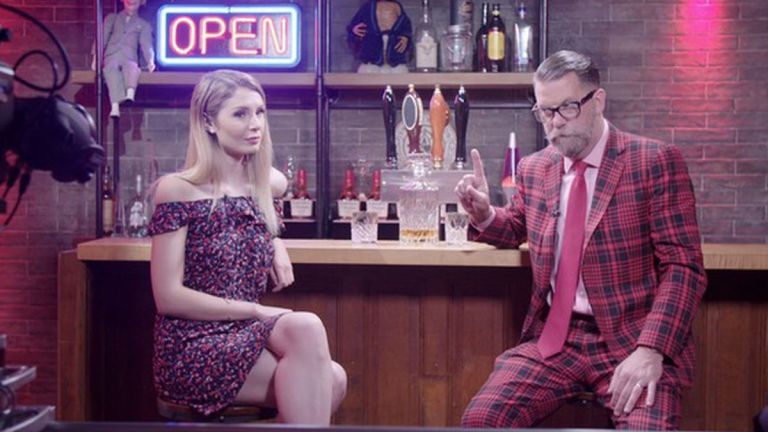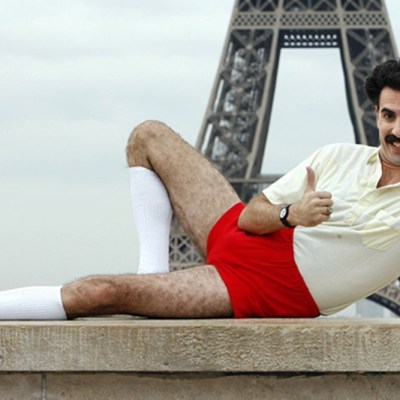How White Noise Exposes the Empty Lies of the Alt-Right
Director Daniel Lombroso considers how his new documentary White Noise gives alt-right leaders, including Richard Spencer, enough rope to “hang themselves.”

Rabbit holes have been on Daniel Lombroso’s mind during the last four years. Perhaps they’ve been there longer since his awareness of the alt-right predates his work on the new documentary White Noise. Yet ever since a fateful day in 2016, when he pointed a camera at a band of young white American men offering up their arms in a Nazi salute, he’s thoroughly explored one of the darkest rabbit holes in 21st century Western culture—and he’s shined a light on how so many got there, only to spread more hate out of it.
A perfect example comes midway through White Noise. Using what Lombroso cites as a strong tool for any cinema vérité documentarian, the montage, he tracks how one of the movie’s primary subjects, alt-right personality Mike Cernovich, spent the final months of the 2016 presidential campaign tweeting across the internet an erroneous smear about Democratic nominee Hillary Clinton. Cernovich falsely claimed she had covered up a series of seizures, including on Sept. 11 of that year during a visit to the site of the World Trade Center attack, and was quietly suffering from Parkinson’s Disease.
“It takes off enough that a few days later it’s on Hannity, and a few days later it’s coming out of the president’s mouth,” Lombroso tells us over Zoom on a late October afternoon. “I mean, the notion that messaging from the President of the United States can begin with the conspiratorial snake oil salesman in California, and ends up in a president’s mouth, it’s just totally astounding.”
It’s also just one of the more overt ways White Noise explores the menace, as well as the shallow initial appeals, of the alt-right movement in the United States.
Produced by The Atlantic, White Noise is a documentary that’s been four years in the making for Lombroso. He’s keen to admit that he didn’t intend for the process to take the entire length of President Donald Trump’s presidential term. But then that may be serendipitous. For unlike other documentaries that study the modern far-right in American life from a distance, Lombroso’s film is the only one doing it from the inside looking out.
With remarkable access to three of the (once) most popular voices in the alt-right movement, Lombroso took a fly on the wall vantage for years as he traveled the world with Cernovich, Lauren Southern, a Canadian white supremacist on YouTube, and American neo-Nazi Richard Spencer. And over the course of White Noise’s 90 minutes, years of interviews, and silent observations, the emptiness of all three’s snake oil becomes overbearing.
Of course they would disagree; Spencer even takes umbrage any time he is called a Nazi. And yet, it was a Spencer-led event in November 2016 that brought White Noise into being. Years before he headlined at the white supremacist “Unite the Right” rally in Charlottesville, Virginia—which led to the murder of anti-racist protestor Heather Heyer—Spencer was jubilant in the heady days following Donald Trump’s surprise electoral victory.
“I started covering the alt-right as a reporter at The Atlantic in about July of 2016, four or five months before the event,” Lombroso says. “I saw just really repulsive stuff bubbling up online, in chat forums, but also on college campuses. I only graduated a couple of years before from school, so I actually brought coverage of the alt-right to The Atlantic.” And among the filmmaker’s ideas that autumn was a profile of Spencer, whom Lombroso views as a modern day equivalent of former grand wizard of the KKK, David Duke.
Even so, the filmmaker was somewhat taken aback when he followed Spencer and a litany of believers into a Washington D.C. ballroom just days after Trump’s election. There Spencer referred to the media as Lügenpresse, the German phrase for “Press of Lies,” which was utilized by Nazi propaganda minister Joseph Goebbels. Spencer’s followers then chanted, “Hail Trump!” and “Hail our people!”
Reflects Lombroso, “At the time, alt-right was used as a fun way for them to rebrand, and it was total bullshit. I mean, they’re Nazis, they’re white supremacists, they’re fascist and that clip was really important in clarifying what they were about.” It went viral and became the launching pad of Lombroso’s first feature film—a film he believes to have crucial historical significance.
“I think seeing them on the rise and seeing how much Trump had empowered them was just completely shocking to them,” Lombroso considers. “I don’t think Trump would exist and be where he is without the alt-right, and the alt-right also wouldn’t exist without Trump. I mean, it’s a really terrifying symbiotic relationship.”
Its historical importance was also only heightened by Lombroso’s own personal background as a Jewish man who has spent a lifetime living with the dangers of far-right extremism.
“Both of my grandmothers are Holocaust survivors, and I grew up very close to them, learning their stories,” says the director. “One of them lost her entire family, except for a brother, and the other one lost her sister in the war. So those were fundamental memories and legacies that I grew up with.”
Given this personal history, it is perhaps surprising so many alt-right personalities would welcome Lombroso and his camera within their ranks. And with the exception of Spencer, it was a challenge gaining access.
“Spencer is the easiest because he’s willing to do almost anything,” Lombroso says. “[But] once he understood that this was kind of an unvarnished vérité film—I think he didn’t totally grasp that—and the more frankly embarrassing moments I caught of him, the more he tried to back off. But Cernovich was difficult, and then Lauren… was next to impossible. It took eight months to convince her to participate in the project. She doesn’t do any press.”
Nevertheless, they all wound up becoming protagonists in the film. Lombroso credits this to each thinking they could “outsmart” him, and that they were all narcissistic enough in their own way to fail to grasp how they would appear on screen. With a vérité approach, the three minor celebrities could only see plenty of floor space to hock their soundbite-deep ideology. But when captured in full context, they were each given enough proverbial rope.
Even so, the filmmaker cultivated complicated relationships with each of them, particularly Southern, whom he describes as “the key to the film.”
“I just built this really interesting kind of journalistic relationship with her where I just kept coming back and trying to convince her that I was sincere in wanting to understand her story,” Lombroso says. “She’s a little bit younger than me, but we’re around the same age and I think that helped. If I was a 60-year-old white dude director, it would have been a lot harder. But even though I find her views totally abhorrent, we had at least some references growing up and watching the same things, listening to the same things.”
And listen to Lauren, Lombrsoso did. Extensively. Over the course of several years, the documentarian traveled with her across the globe as her YouTube celebrity grew. On that video-sharing site, she posted alleged makeup tutorials where she would write the words “Fuck Islam” across her cheeks; and she’d fly to Russia in order to prove there is no “collusion” while wearing Soviet styled military caps. With several years’ reflection, she later tells Lombroso in the film that these were “trolling politics.” She sold them with a chirping smile.
That is of course the danger. As Lombroso recalls, when he followed Southern all the way to the European Parliament, Janice Atkinson, a former British member of the EU legislative branch, cooed, “She can sell it to my sons better than I can sell it.” Or, as Lombroso clarifies, “She’s young, obviously part of her package is that she’s attractive and she uses it to radicalize people.”
At the same time, during the course of making White Noise, Southern showed the most potential for change. The filmmaker caught on camera what appeared to be far-right radio host, and Proud Boys founder, Gavin McInnes sexually propositioning Lauren over the phone (McInnes is married and denied that he actually did so). And Lombroso was able to document Southern’s growing weariness with this kind of gross, leering attention.
“With Richard and Mike, no, there’s very little regret, there’s very little self-awareness,” Lombroso says. “With Lauren, dealing with a lot of the sexual harassment and abuse from men… I think there was a moment, it’s act two in the film, which was about a year and a half ago filming, when she was dealing with it so dramatically and nonstop. It was just a never ending torrent of shit from these guys that there was a chance or a hope that she might change.”
But one of the most telling things about White Noise is it’s not a reclamation story or the “Hollywood narrative,” as Lombroso shrugs.
“In pitch meetings, everyone was looking for the hallmark story of the Nazi who reformed. There’s a few amazing examples like Derek Black, but it’s so rare. The hundreds of people I interviewed and spent time with, I can count on one hand the number of people who reformed and owned up.”
So even as Southern took a year off from the alt-right rat race, and had a child with a man who was not white, her views never changed. In fact, they hardened. Which makes her desire in White Noise to not talk about the ethnicity of her child’s father all the more striking.
“I think Lauren’s omission of her boyfriend [and] now husband is intentional,” Lombroso says. “I think she’s potentially embarrassed. She wants to minimize as much as possible how much of a blatant contradiction that is. I mean, she is the avatar for white femininity, for white baby-making, and for the preservation of the white race.” And she’s doubled down on that line of thinking, if not in the specific gender dynamics, after taking a year off.
More insidious still is how figures like Southern can trade in their YouTube hate-mongering for the prestige of establishment notoriety. After going to Paris and filming Middle Eastern refugees left to live in tents, she and alt-right filmmaker Caolan Robertson created a repugnant piece of propaganda called Borderless. It was screened for European policymakers.
“She was invited to the European Parliament,” Lombroso remarks. “She met her partner, and with the benefits of her privilege as a young white person could just wipe that stuff away. So yeah, the EU speech gave her a tremendous amount of credibility, a stunning amount. And she’s really not sorry about anything.”
As the toast of far-right European Parliament members’ staffs—with 10 percent of elected members currently belonging to the anti-immigrant and extremist Identity and Democracy group—Southern screened Borderless. The documentary pivots on a misleading montage where a series of refugees say they wish they stayed in their native countries. Out of context, Southern and Robertson present this with goofy inspirational music.
In White Noise, Lombroso provides context. In tent cities beneath highway overpasses, Southern lies and manipulates refugees to get the soundbites she desires.
“It’s terrible and terrifying,” Lombroso says. “Coming from The Atlantic, we just had the most careful, rigorous journalistic standards. Everyone had to sign a release form. Everyone knew my name and how I worked. If they asked about my background, I’d say I’m Jewish. Nothing was a lie. And in that scene, you see on camera Lauren give a fake name. She says, ‘My name is Alex.’ To give you context beyond [White Noise], she would represent herself all sorts of ways, most often as a journalist who was very favorable to refugees and wanted to hear their story and spread the word. They had no idea what they were getting themselves into.”
Yet Lombroso’s instinct to maintain the vérité approach of bearing witness to this sinister manipulation could create an ethical dilemma. These are people in the worst situation imaginable, living in tents and unable to get a job because the EU will not give them work permits no matter what they do.
Says Lombroso, “For me, it just became about exposing how horrible her treatment was and how inconsistent it was with what we saw.”
Such instances demonstrate the inherent challenge of Lombroso’s approach, but also the reason he felt compelled to present White Noise as a documentary that follows three alt-right celebrities to a bitter end. Unlike so many other political documentaries, there are no talking heads drawing direct comparisons to the 1930s, as Lombroso might do in a Zoom conversation, nor is there a voiceover narration or heavy-handed musical score, asking the viewer to feel a certain way.
Lombroso is acutely sensitive to criticism that his film would become a platform or amplifier for the subjects’ hateful rhetoric. Instead of presenting their talking points without context, Lombroso argues, he is drowning them in excessive context.
“I think our realization is that these folks have followings in the millions, and a huge amount of influence already,” Lombroso says. “So it was on me as a filmmaker and journalist to take their ideas seriously, but slowly dismantle them. I think the vérité format does that extremely well… you’re able to tie someone up in his loops, prove them wrong, expose their psychology and just how abhorrent they are in a way that’s much more revealing, I believe, than any expert at the Brookings Institution could ever do.”
Lombroso views the intimate access he had with these figures a unique opportunity and his biggest asset. By stepping back, he could capture the whole alt-right landscape in the age of Trump with a single snapshot of historic value.
“The way the alt-right recruits is by telling the story that we’re the descendants of Greeks and Romans,” says the filmmaker. “That we are strong men and that if you follow us, you’ll be happy, you’ll be confident, and you’ll feel better. And the real way to dismantle that isn’t for an expert to tell you it’s not true; it’s to really just show how empty it is.”
It’s also what the finished film conveys in 2020. Over recent months, Lombroso and The Atlantic have screened White Noise for a variety of audiences, and all of them, including conservative ones, had the same reaction of revulsion toward these people and where they end up.
By the time White Noise’s credits roll, each of the three subjects—Spencer, Cernovich, and Southern—have been left behind by their movement. Cernovich and Southern chose to step away, somewhat weary of the mess they helped create, though each has tried to circle back. In the case of Southern, it is continuing her online activism in Australia after Borderless’ warm reception among the far-right; Cernovich, meanwhile, contemplates a run for Congress after transitioning to selling skin care products and other seeming grifts.
And Spencer? At picture’s end, he is divorced and living back home in his mother’s extravagant Montana house, playing the piano and riding ski lifts alone while fantasizing about there one day being a Richard Spencer Boulevard.
Muses Lombroso, “Richard is an ideologue. Richard believes it, but even with him, he’s intoxicated by the fame. So I think it’s sort of a spectrum. Richard is a true believer. Mike believes next to nothing, but all of the motivations are mixed.”
What all three have in common, however, is an indignation at how they appear in White Noise.
“There’s a reason they despise the film,” Lombroso tells me. “They’re all very unhappy with the way it came out, because I think in their minds they’re the heroes of their own story. And now they’re looking in the mirror and seeing that for most people, it just doesn’t look that way.”
He goes on to add, “The New York Times just wrote a review and said the three must be so excited about this film. And if only the reviewer at The Times knew what my inbox looked like for the past two months in my phone. I mean, they’re furious because they know that this film just dismantles their ideology and their ability to recruit. It makes them look like fools.”
The alt-right, at least as how Cernovich, Spencer, and Southern, conceived of it, is effectively dead. But its ideology and aspirations live happily on in the mainstream every time Fox News hosts spread conspiracy theories that sound only slightly removed from the most heinous rhetoric Cernovich propagated on Twitter; and it breathes deeply each instance President Trump refuses to denounce a QAnon conspiracy theory that has morphed into the new faceless leader of far-right propaganda online.
The rabbit hole still exists, just one click away. But at least with White Noise, some younger minds might see the ugly reality such blind hate leaves in its wake.
White Noise is available on VOD now.


